23 October 2020
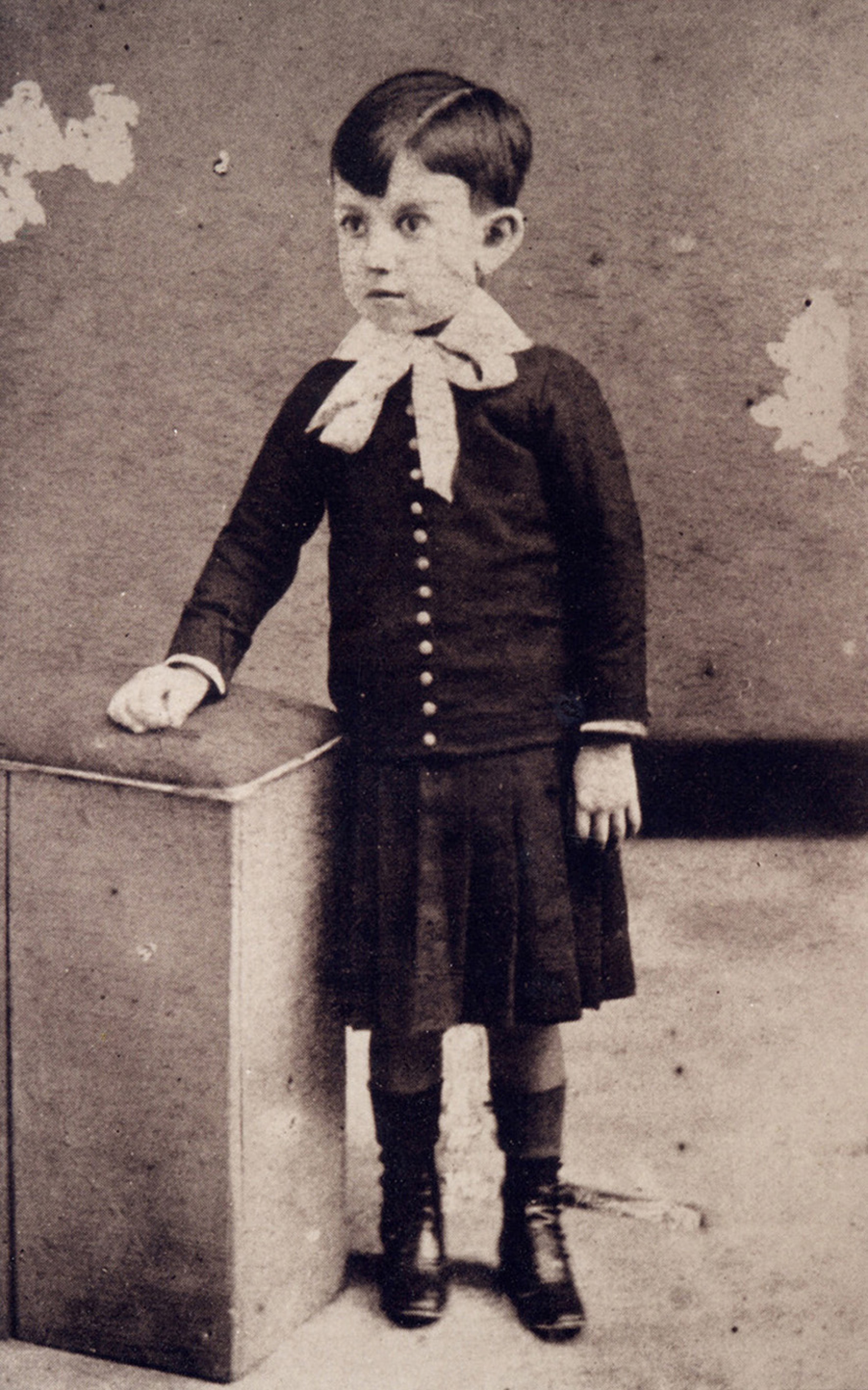 Pablo Picasso, 1884 Picasso: Engravings and Ceramics From The House of His Birth
Pablo Picasso, 1884 Picasso: Engravings and Ceramics From The House of His Birth
Pablo from Malaga
Born on October 25, 1881 in Malaga, Spain, Pablo Picasso’s full name takes about two lines: Pablo Diego José Francisco de Paula Juan Nepomuceno María de los Remedios Cipriano de la Santísima Trinidad Martyr Patricio Clito Ruíz y Picasso.
We call him Pablo Ruiz Picasso for short, especially biographers and Malagans. The surnames Ruiz and Picasso are actually equally important in the city of Malaga. The origin of the Malagan Ruiz family dates back to the 15th century. As for Picasso, the mother who started the Malaga branch was Tomasso Picasso Musante, the grandmother of little Pablo. In 1880, José Ruiz Blasco of the Ruizs and Maria Picasso Lopez of the Picassos got married at the Church of Santiago. After a year or so, we all know who came into the world.
 Pablo Picasso’s Blouse with the Letter “P”, Malaga, c. 1881. Fundación Picasso Picasso: Engravings and Ceramics From The House of His Birth
Pablo Picasso’s Blouse with the Letter “P”, Malaga, c. 1881. Fundación Picasso Picasso: Engravings and Ceramics From The House of His Birth
Picasso takes his famous last name from his mother Maria, and his artistic talent from his father, José Ruiz Blasco, who was an art teacher. Picasso made his first two works in about 1888 and 1889, using the painting materials his father gave him. The first is the "Malaga Bridge View", where he describes the city he was born and grew up in, and the second is the "Yellow Picador". But actually before these two pictures he copyies a painting of his father Jose. And in that painting you can see the Malaga influences. It is possible to see Picasso's love for Malaga also in some of his poems. His great interest in bullfighting can be clearly observed on the occasion of his second official "Yellow Picador".
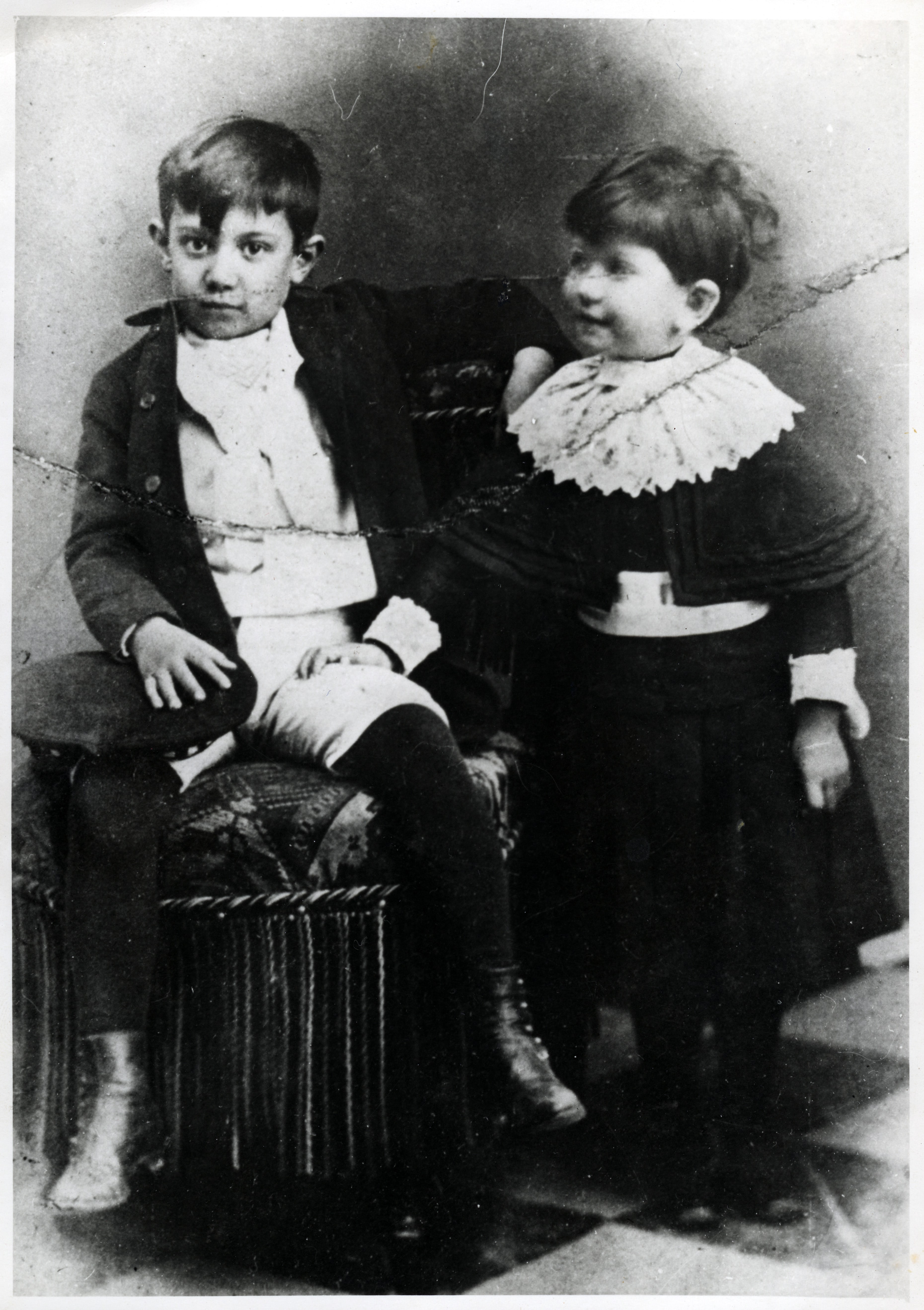 Pablo Picasso and his sister Lola
Pablo Picasso and his sister Lola
Picasso: Engravings and Ceramics From The House of His Birth
Family Matters
Picasso's sister, Lola, who’d be his playmate and friend, was born in 1884. Conchita was added to these siblings in 1887. But unfortunately, little Conchita's life was cut short enough to affect Pablo and his family deeply. Conchita contracted a deadly disease in 1895 while his family was living in La Coruña. And little Pablo, with his child’s mind, decided to stop painting and drawing if his little sister would get rid of this disease. Conchita succumbs to disease; and maybe this is why there are thousands of works that Picasso has created until the end of his life ...
Picasso also paineds his own family in his later years. Among the most famous of these works is Françoise Gilot, the mother of two children and with whom he had a very turbulent relationship. These family landscapes, depicting Françoise reading books and playing with children, glorify the home interior and an ordinary story, a testament to the interiors of the 17th century Netherlands or 19th century German Biedermeier paintings, and the warmth of the home of the children; of Claude about six years old and Paloma, about three, playing games.
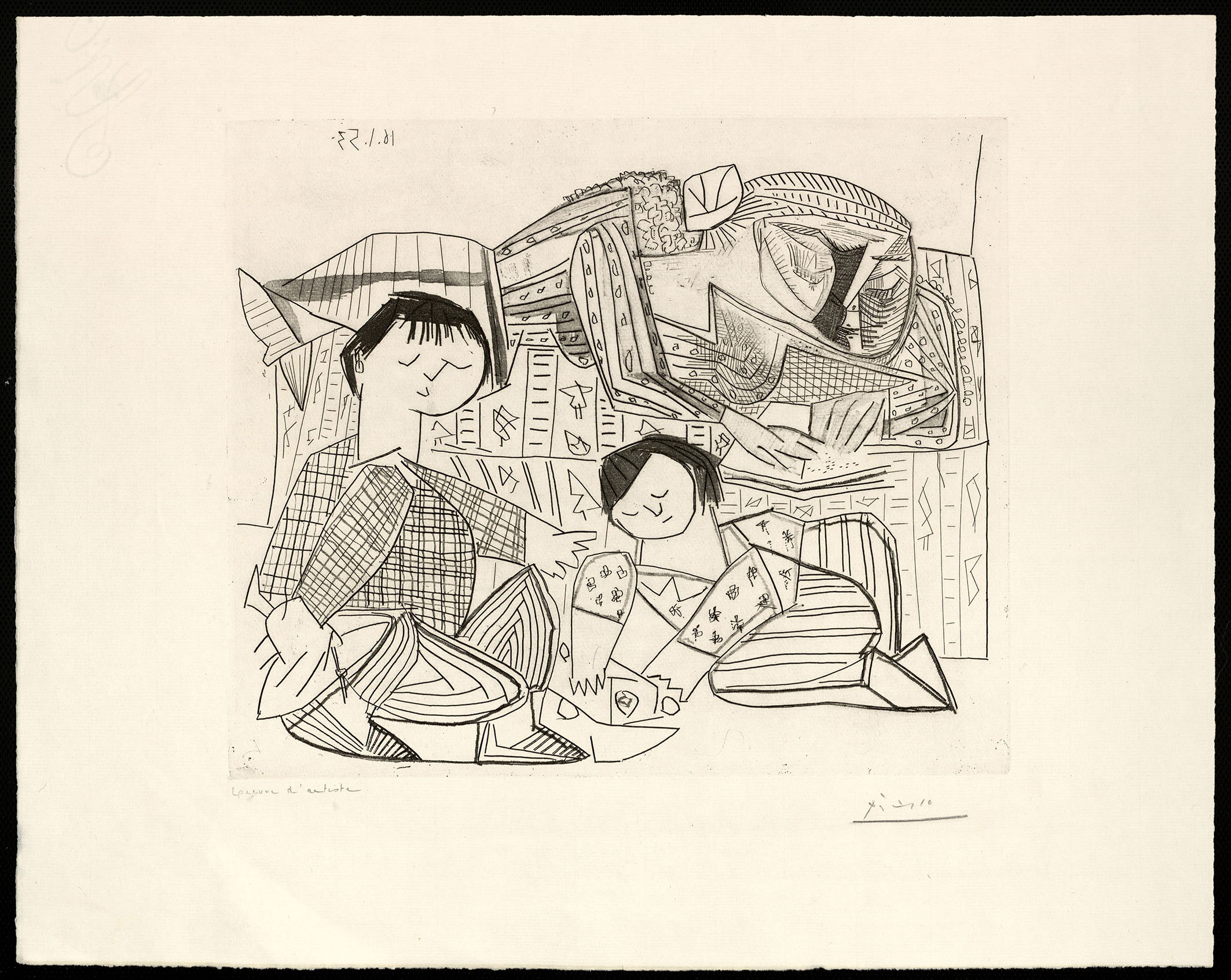
Françoise, Claude, Paloma: Reading and Playing II, Paris, 16 January 1953. Etching printing on copper, stain printing, scraping pen, 37,8 x 47 cm. FPCN: 1427, Picasso: Engravings and Ceramics From The House of His Birth
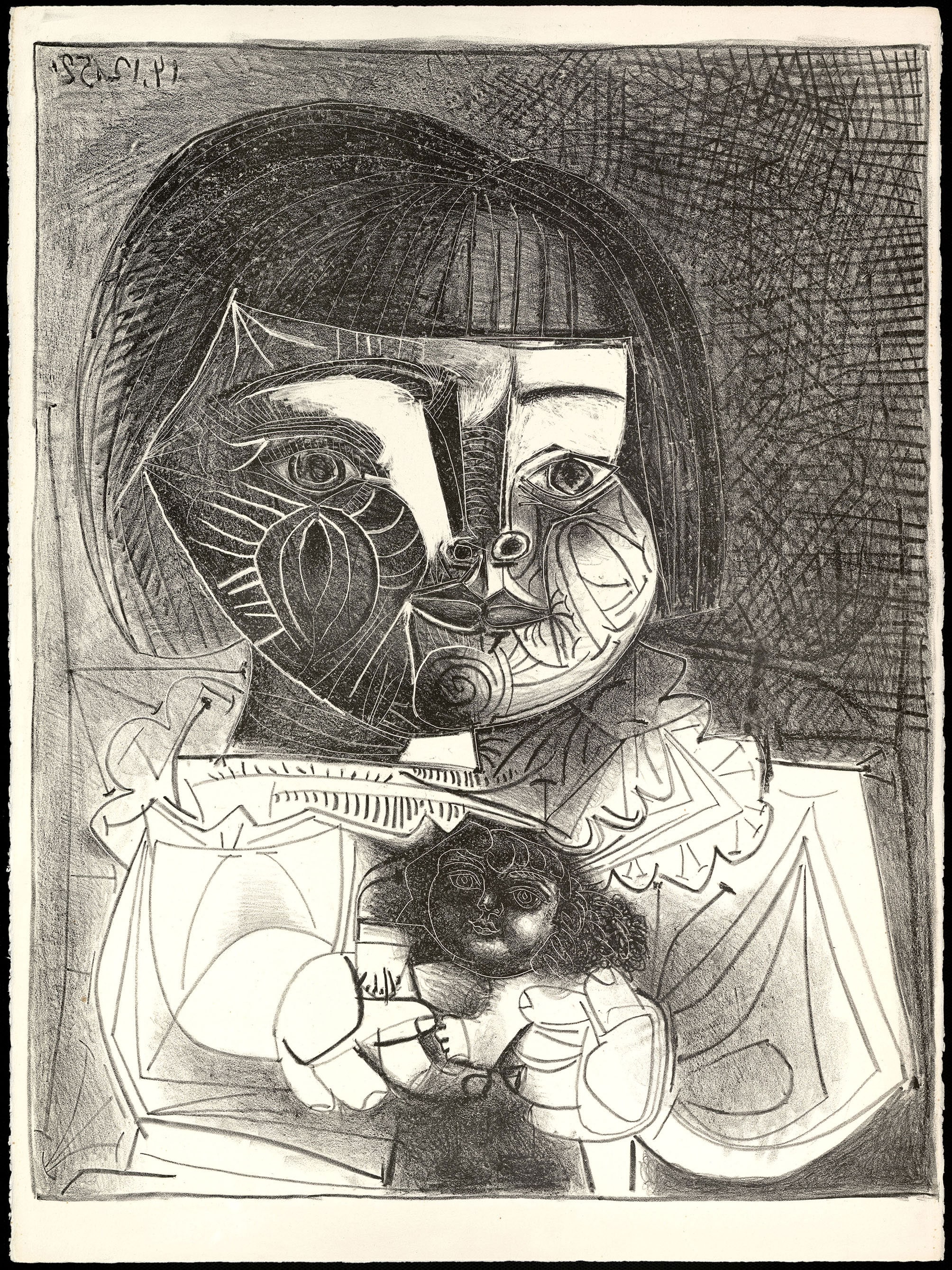 Paloma and Her Doll on Black Ground
Paloma and Her Doll on Black Ground
Vallauris, 14 December 1952
Lithograph
76 x 56,2 cm
FPCN: 1944
Picasso: Engravings and Ceramics From The House of His Birth
Picasso's image of a woman who preserves her horizontal position in the depictions of Françoise, and in some cases writes or looks as if she is drawing something for later reading, Picasso started with portraits of his mother and sister Lola and Olga, Marie-Thérèse Walter is part of a rich thematic tradition, which Françoise herself and Jacqueline personally pursued with different images while reading.
 Young Girl Inspired by Cranach (Françoise)
Young Girl Inspired by Cranach (Françoise)
Paris, 26-27 March 1949 (or 28 March)
Lithograph in black on ivory wove paper
66 x 49,7 cm
FPCN: 1899
Picasso: Engravings and Ceramics From The House of His Birth
Staggering Beauty
In the imagination of the broad masses, Picasso is represented best by women. Picasso describes the enthusiasm, energy, will and even hope for life in women. In the 1920s, when his marriage to Russian ballerina Olga Khokhlova was completely deadlocked, Picasso found an escape, and therefore a way of freedom, by meeting with surrealist youth who saw himself as a pioneer and inspiration. He was quick to adopt the new aesthetic he took from cubism. The "Two Naked Women" series allowed us to closely monitor Picasso's creation process: The figures, following their fuzzy initial form, left themselves to the traditional understanding of depiction, with a deconstruction rising from there, first one and then both, a lightened scene that exemplifies the surrealist revolt perfectly. The shocking beauty put forward by André Breton was echoed in Picasso's description of Gertrude Stein: "For me, a painting is the sum of destructions."
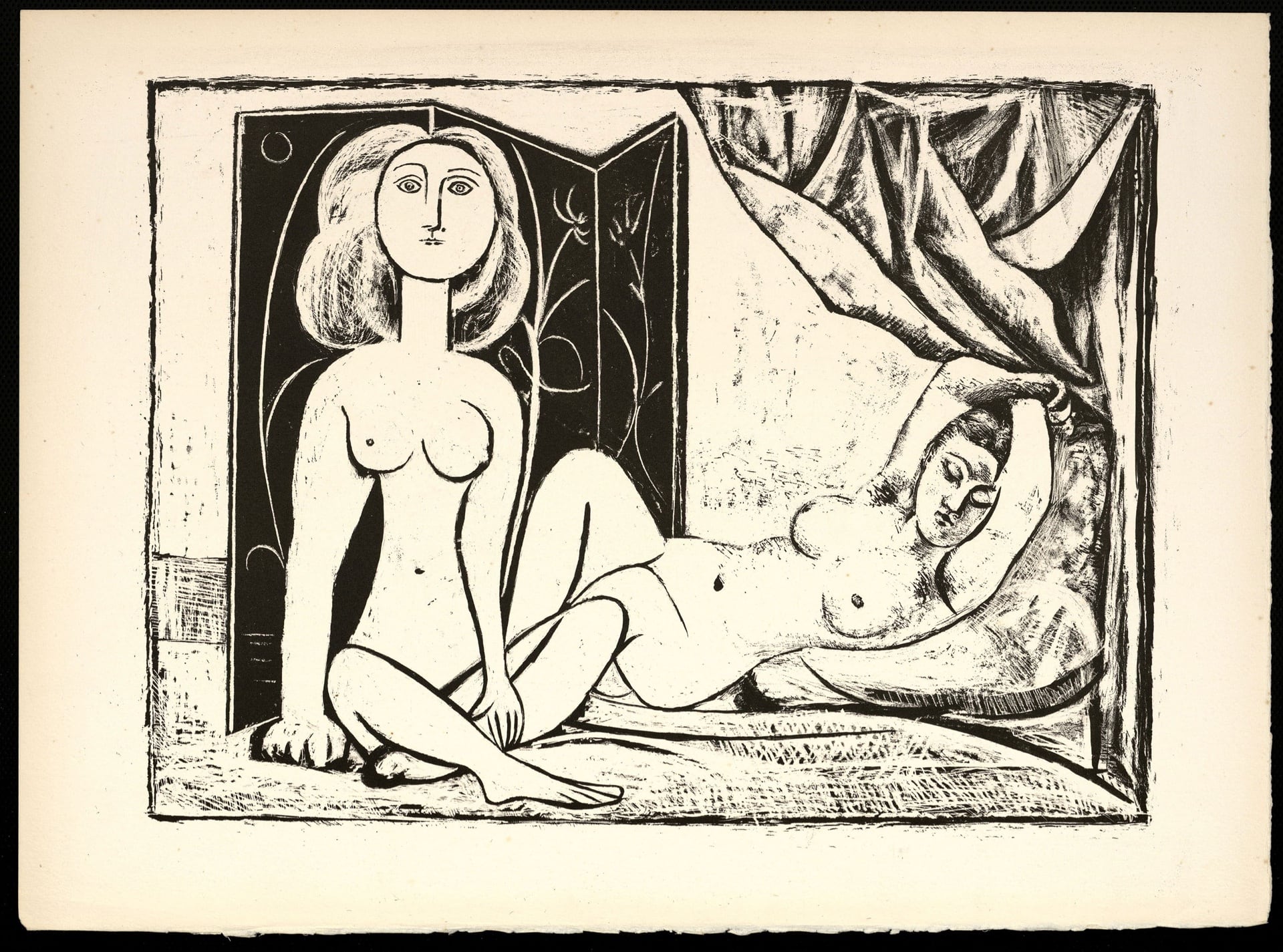 Two Nude Women, Paris, 17 January 1946. Brush on stone, pencil and scraping knife 33,1 x 44,5 cm. FPCN: 1806. Picasso: Engravings and Ceramics From The House of His Birth
Two Nude Women, Paris, 17 January 1946. Brush on stone, pencil and scraping knife 33,1 x 44,5 cm. FPCN: 1806. Picasso: Engravings and Ceramics From The House of His Birth
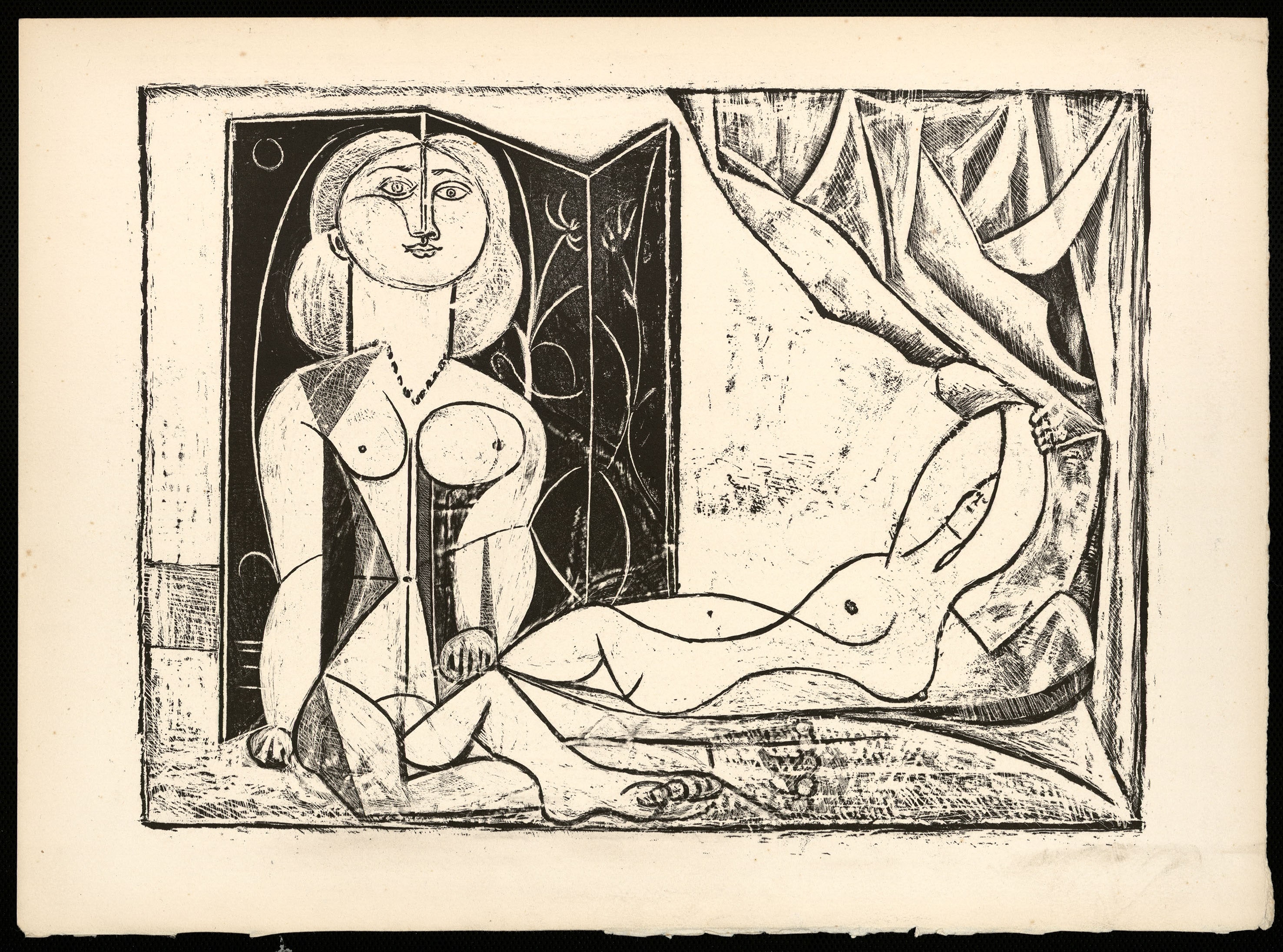 Two Nude Women, Paris, 25 January 1946. Brush on stone, pencil and scraping knife 32,8 x 44,4 cm. FPCN: 1809. Picasso: Engravings and Ceramics From The House of His Birth
Two Nude Women, Paris, 25 January 1946. Brush on stone, pencil and scraping knife 32,8 x 44,4 cm. FPCN: 1809. Picasso: Engravings and Ceramics From The House of His Birth
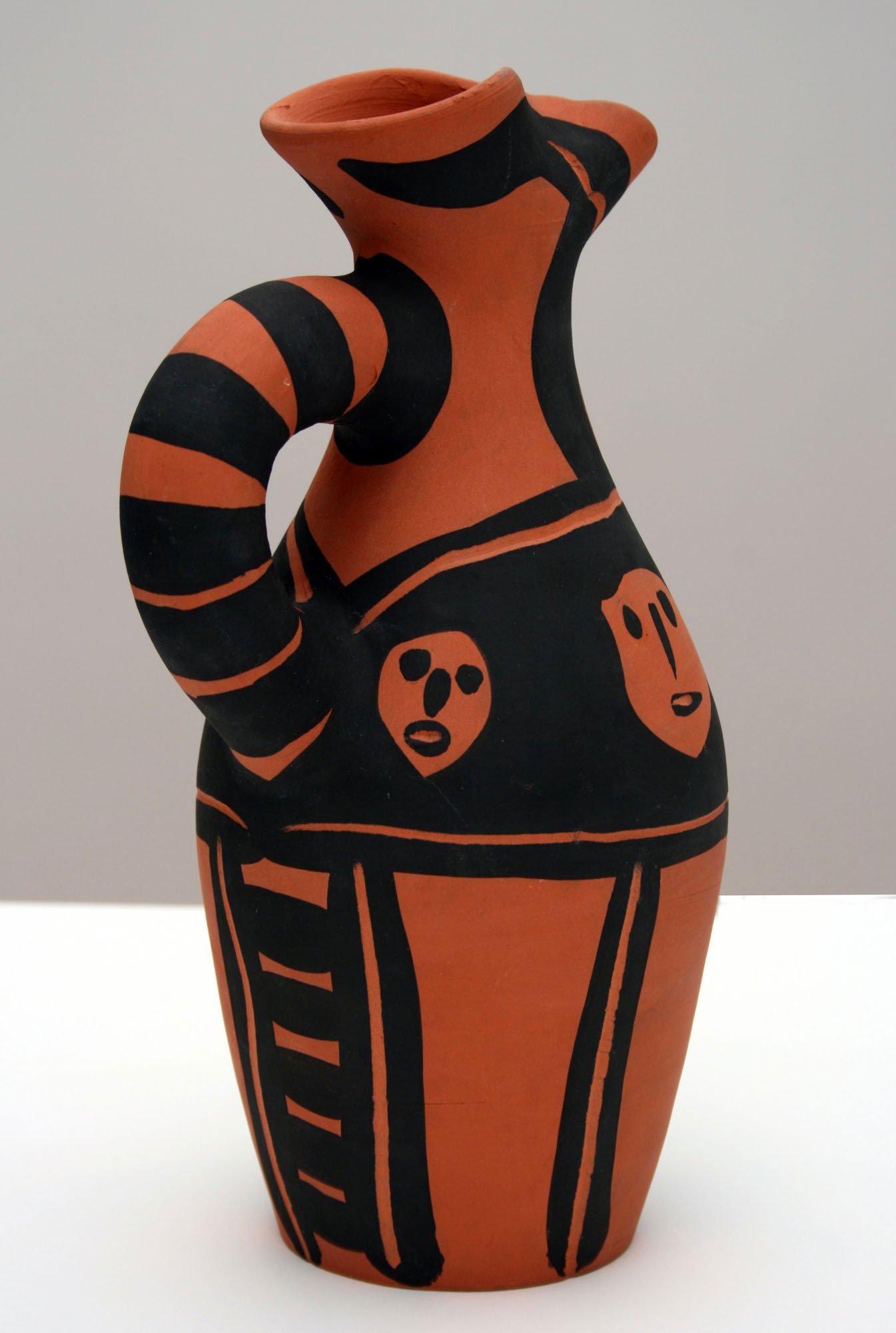 Yan Petites Tetes
Yan Petites Tetes
Vallauris, 30 August 1963
Ceramic jug painting in black
Edition Picasso. Madoura Plein Feu, 1/300
27,1 x 11,5 x 15 cm
FPCN: 2072
Picasso: Engravings and Ceramics From The House of His Birth
Closed in an interior, which is also associated with the women depicted in the harem under the influence of Delacroix, now their number has dropped to two and in an isolated, naked, closed room, these women take their share from the defeat of surrealism in this episode and are condemned to the transformation, whose definition is found in Picasso's repeated words by Françoise Gilot: “Ah! Of course, you don't understand that these women are not just put there like a bored model. They are the prisoners of those cedars, like caged birds. I have trapped them in a situation where there are no gestures and this motif is repeated, because I am trying to capture the movement of flesh and blood through time. And I want to underline the grief created by pure meat, "beauty", the traces that show that times have changed make him alarmed even in the moment of victory. "
In his engravings, Picasso appears as a sculptor and becomes a kind of contemporary Pygmalion; he enjoys observing his model before, but then his eye only sees his work. The movie The Flower Girl / Pygmalion is a kind of vulgar comedy adapted from George Bernard Shaw's play of the same name (it was shown in the Picasso: Filmic Narratives program organized by Pera Film in 2010.)
Picasso’s Ceramics
Pablo Picasso started his ceramics work as of 1946 and continued until his death in 1973. Picasso visited the ceramics festival in Vallauris city in Southern France in 1946, discovered the Madoura pottery workshop there and established a long-lasting friendship and business relationship with the workshop owners Georges and Suzanne Ramié. The ceramics he produced here went on sale with the Madoura label.
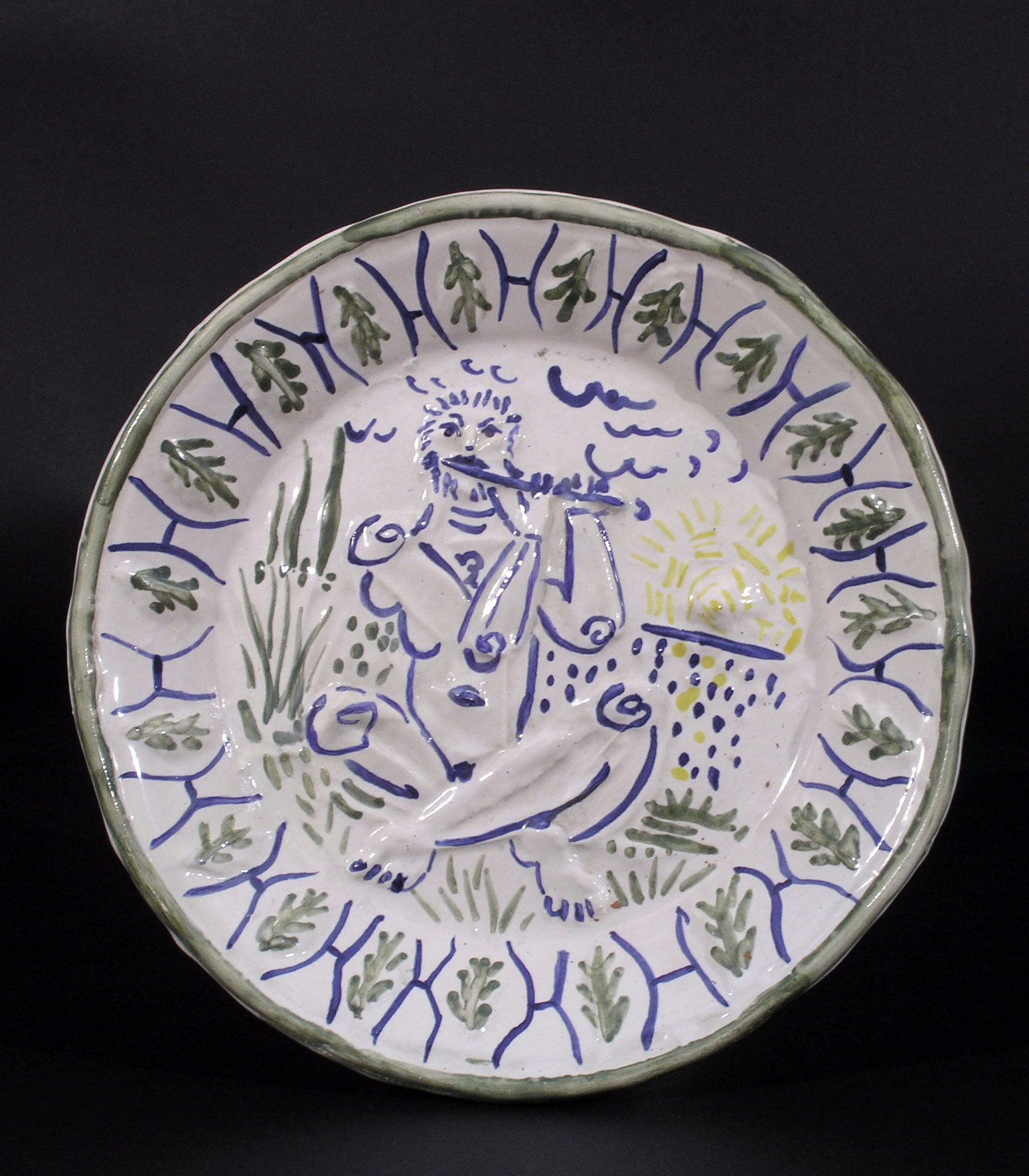 Flute Player, Vallauris, 1951. White clay plate, painted in blue, green and yellow, decorated with oxide and white glaze Edition Picasso. Original Picasso print. Masoura Plein Feu, 40, 24,4 x 24,4 x 3,9 cm. FPCN: 2030. Picasso: Engravings and Ceramics From The House of His Birth
Flute Player, Vallauris, 1951. White clay plate, painted in blue, green and yellow, decorated with oxide and white glaze Edition Picasso. Original Picasso print. Masoura Plein Feu, 40, 24,4 x 24,4 x 3,9 cm. FPCN: 2030. Picasso: Engravings and Ceramics From The House of His Birth
Painter Abidin Dino (1913, Istanbul - 1993, Paris) established a close friendship with Picasso during his stay in Paris and had the opportunity to work one-on-one with the artist in Madoura workshop. From Dino's memoirs, Picasso's passion for ceramics can be read as follows: “When I was little, I kneaded shapes from dough and then baked them on the stove in the kitchen. Sometimes I messed up the lady who worked in the kitchen would get mad at me.”
Curiosity for the Ancient Times
The roots of Picasso's enduring admiration for themes in ancient art were that he began his artistic education in a world dominated by imitation and reproduction of classical models of Greek and Roman art. The "Three Blessings" in mythology, namely Aglae, Talya and Eufrosine, daughters of Zeus and Eurynome, appeared in the engraving "Three Bathers" in the image of those who entered the water. The Three Bathers was one of the themes that we encounter in all periods of Picasso; just like the Jester, who is always in the accused chair. Considering the disassembling approach of cubism, from Gosol's ocher and going through primitivism, to the classical world and to the 50's, Bathing Women knew how to approach most of the windows in different periods.
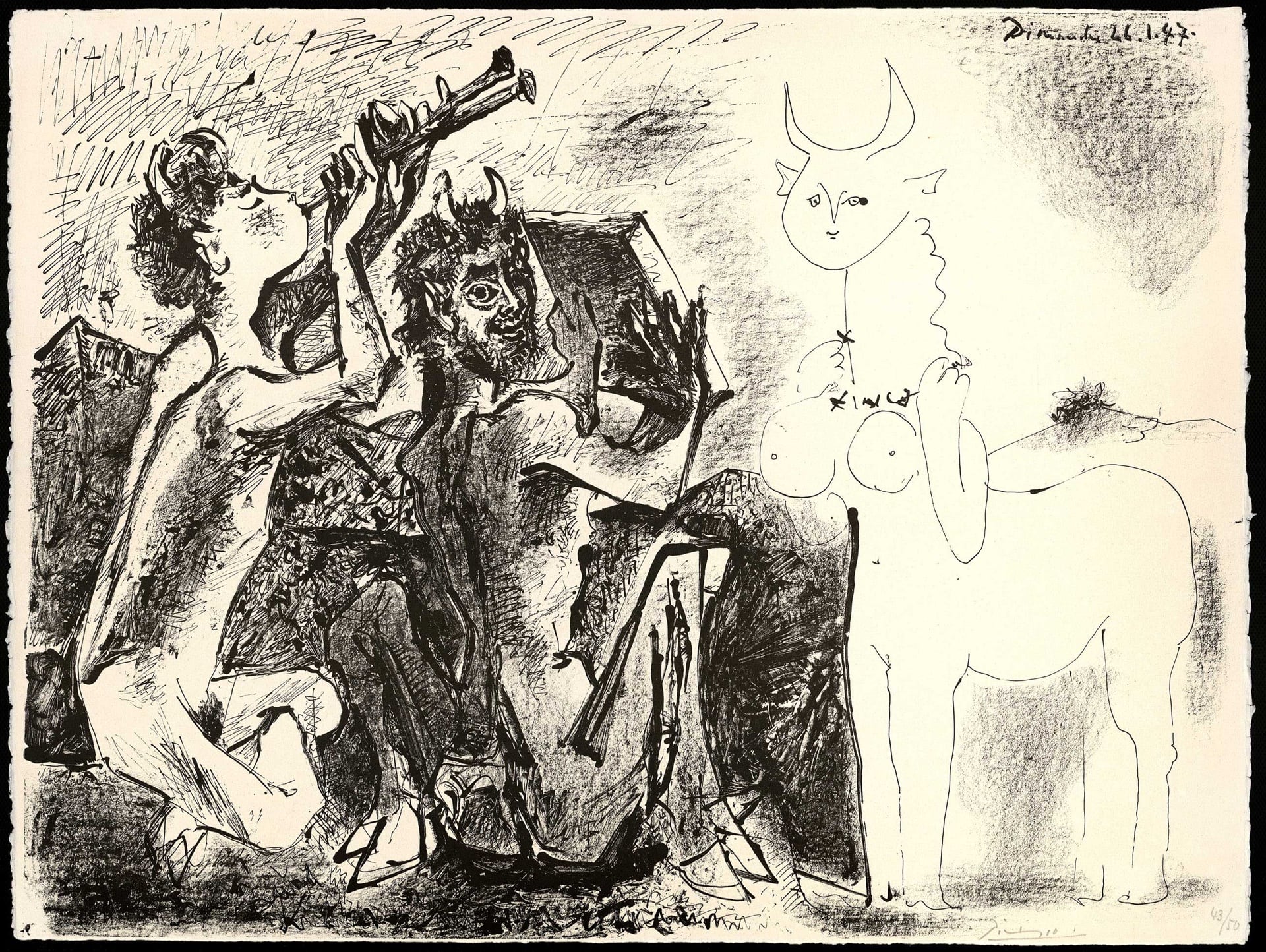 The Fauns and the Centauress, Paris, 26 January 1947. Lithography pen, pen, brush and scraper knife on lithography paper transferred to stone. 43/50, 49,7 x 66 cm. FPCN: 1839. Picasso: Engravings and Ceramics From The House of His Birth
The Fauns and the Centauress, Paris, 26 January 1947. Lithography pen, pen, brush and scraper knife on lithography paper transferred to stone. 43/50, 49,7 x 66 cm. FPCN: 1839. Picasso: Engravings and Ceramics From The House of His Birth
The peculiar feature of this engraving that distinguishes it from its counterparts is that it is a coincidental shadowy layer that accompanies the refined lines of acid etching printing, distinguished and aristocratic lines, and it is buried long before it entered the cut print on the plate. In the meantime, a superficial oxide layer remained on the zinc floor, creating a hazy effect when printed, a greyish feel that suppresses blue, and an atmosphere reminiscent of late summer melancholy. This story thus became a part of the creative process, an element that puts sadness against the long days of beauty and light.
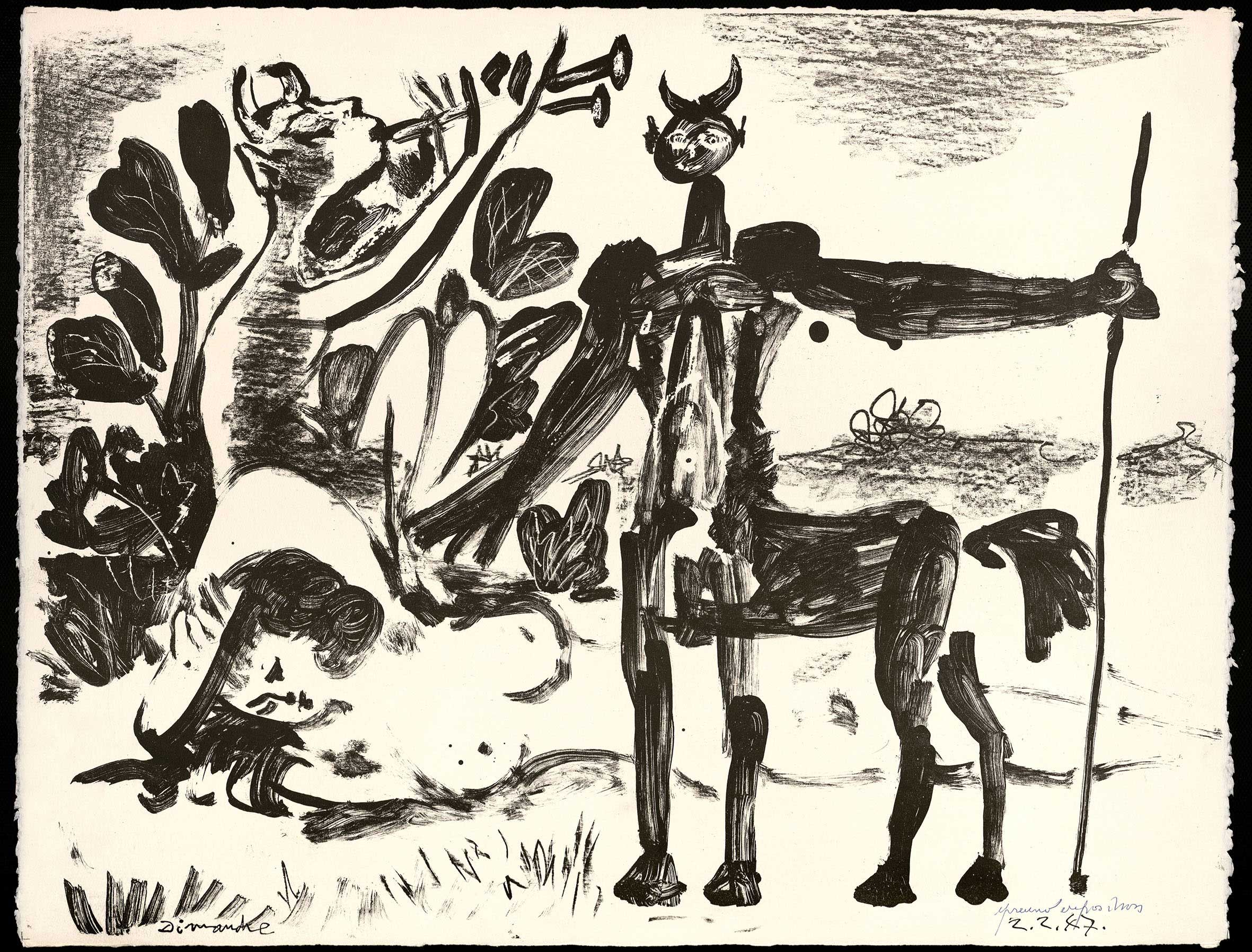 Paris, 2 February 1947. Ink wash on lithography paper transferred to stone, gouache, lithography pen and scraping knife, 50,3 x 65,6 cm. FPCN: 1841. Picasso: Engravings and Ceramics From The House of His Birth
Paris, 2 February 1947. Ink wash on lithography paper transferred to stone, gouache, lithography pen and scraping knife, 50,3 x 65,6 cm. FPCN: 1841. Picasso: Engravings and Ceramics From The House of His Birth
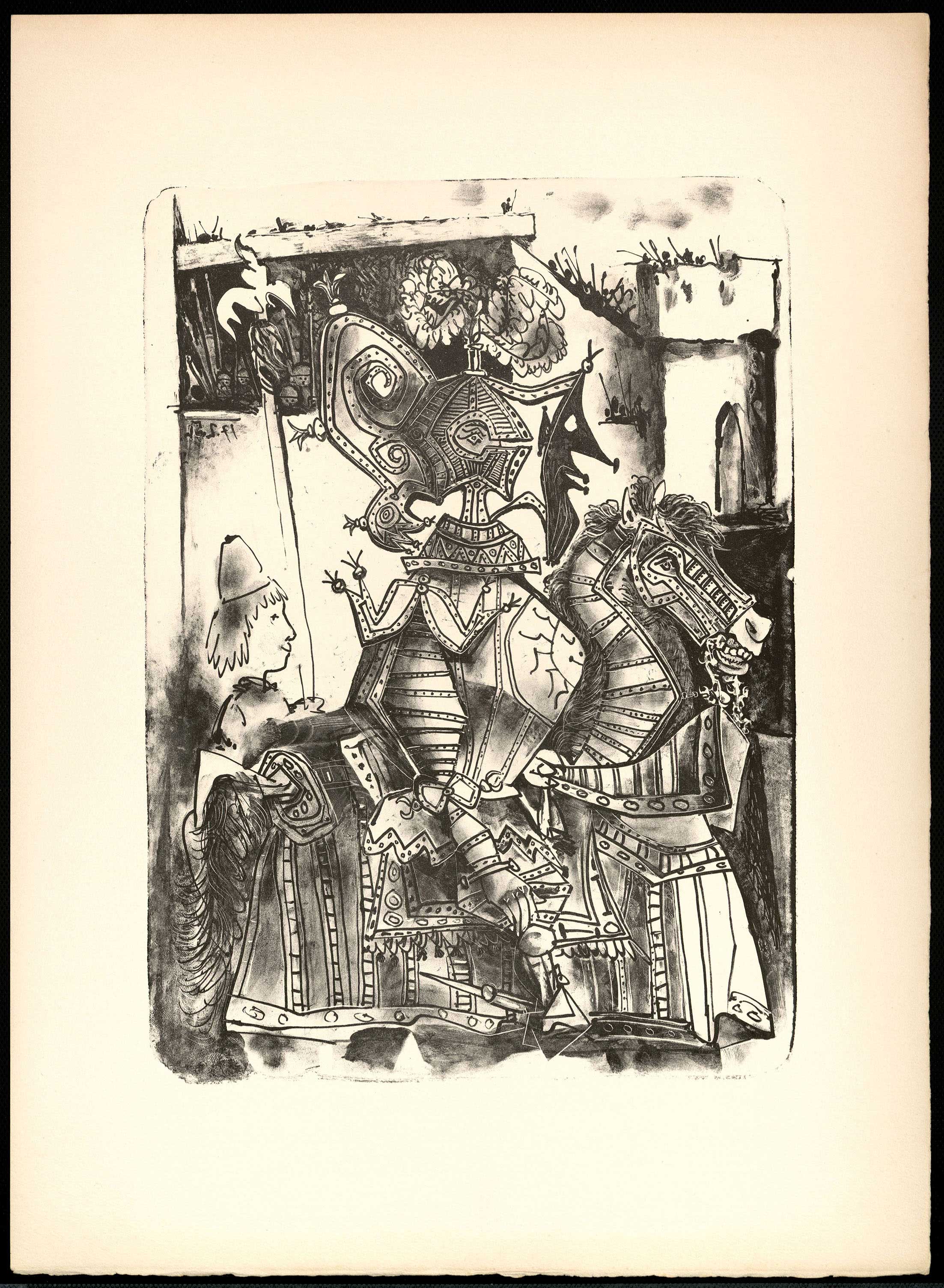 The Knight and the Page
The Knight and the Page
Vallauris, 17 February 1951
Pencil, pen, ink wash and scraper on stone
52,2 x 38 cm
FCPN: 1932
Picasso: Engravings and Ceramics From The House of His Birth
In the 1930s, passionate centaurs (horses with human heads), figures transformed into pikadors, drinking bells, flute-playing fauns (goat gods) in the 1940s were depicted with energetic lines. The ability of the artist to combine human and animal elements of classical mythology heroes such as centaurs and fauns in the same figure, interweaving his judgment and pure instincts, resulting in a psychology and psychoanalytic interpretation that can limit confessions about his personal life.
The Knight and the Page
The disasters brought on by the war went on without hiding. Picasso, who evaluated the painting as just a sketch in the footsteps of Tristan Tzara, was under the influence of the associations in his mind for a long time. He continued to draw knights in armor, which seemed vague during his exploration of the past. He made these drawings from a knight with inlaid armor with graceful borders, heads embedded in his strange visor helmets, accompanied by a butler, with long conical caps, spinning his horse against a beautiful's window. Picasso had a strange delight in depicting the intricate motifs of helmets, the joints of armor, and the saddle of a horse. When he draws, he always gets a little further away from his inspiration: fear of robots. Humor replaced emotion. He continued to draw, paint and engrave the play of knights and henchmen. Kahnweiler thought it wasn't just his painting that inspired this strange parade. "I suspect that a series of Ivanhoe illustrations that appeared in L'Humanite at that time also prompted Picasso to think about them." When Kahnweiler traveled to Vallauris to visit him in March, this time he found him painting a "Very Pinturicchio-like" lithography depicting a knight and a servant. " – Antonina Vallentin
Known as the The Knight and the Page, this series has a special place in Picasso's graphic production with its unique theme. The story of the departure of a medieval knight who was not fully understood whether he went to a spear race, war or the Crusades, accompanied by his servant, in some engravings in a city landscape with a woman and several young people looking after him. The theme of chivalry is indeed an unusual issue in Picasso's art, especially considering that he made many variations on the same subject.
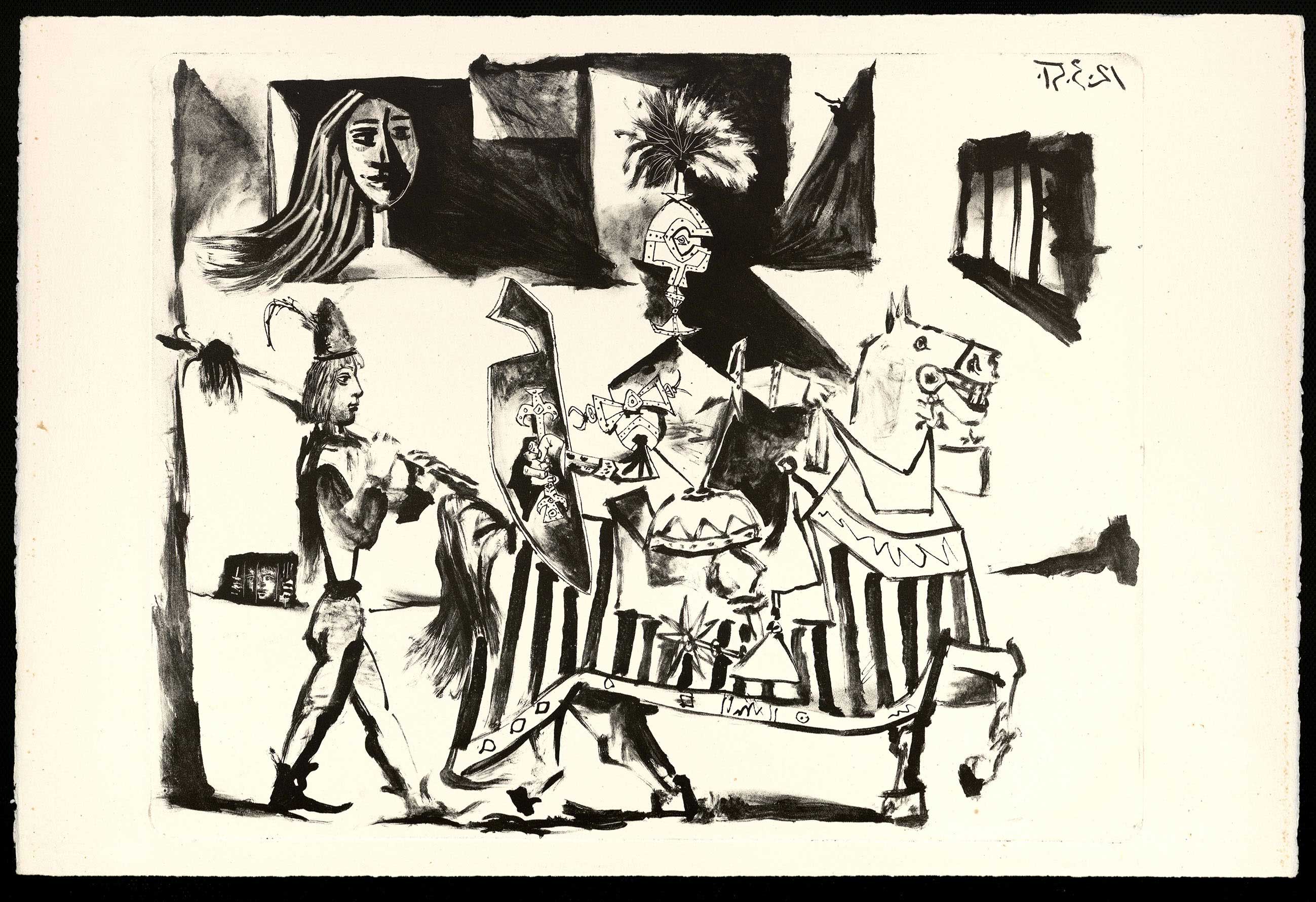 The Departure, Vallauris, 12 March 1951. Ink wash, pencil and scraper knife on zinc, 38,2 x 57,1 cm. FCPN: 1933. Picasso: Engravings and Ceramics From The House of His Birth
The Departure, Vallauris, 12 March 1951. Ink wash, pencil and scraper knife on zinc, 38,2 x 57,1 cm. FCPN: 1933. Picasso: Engravings and Ceramics From The House of His Birth
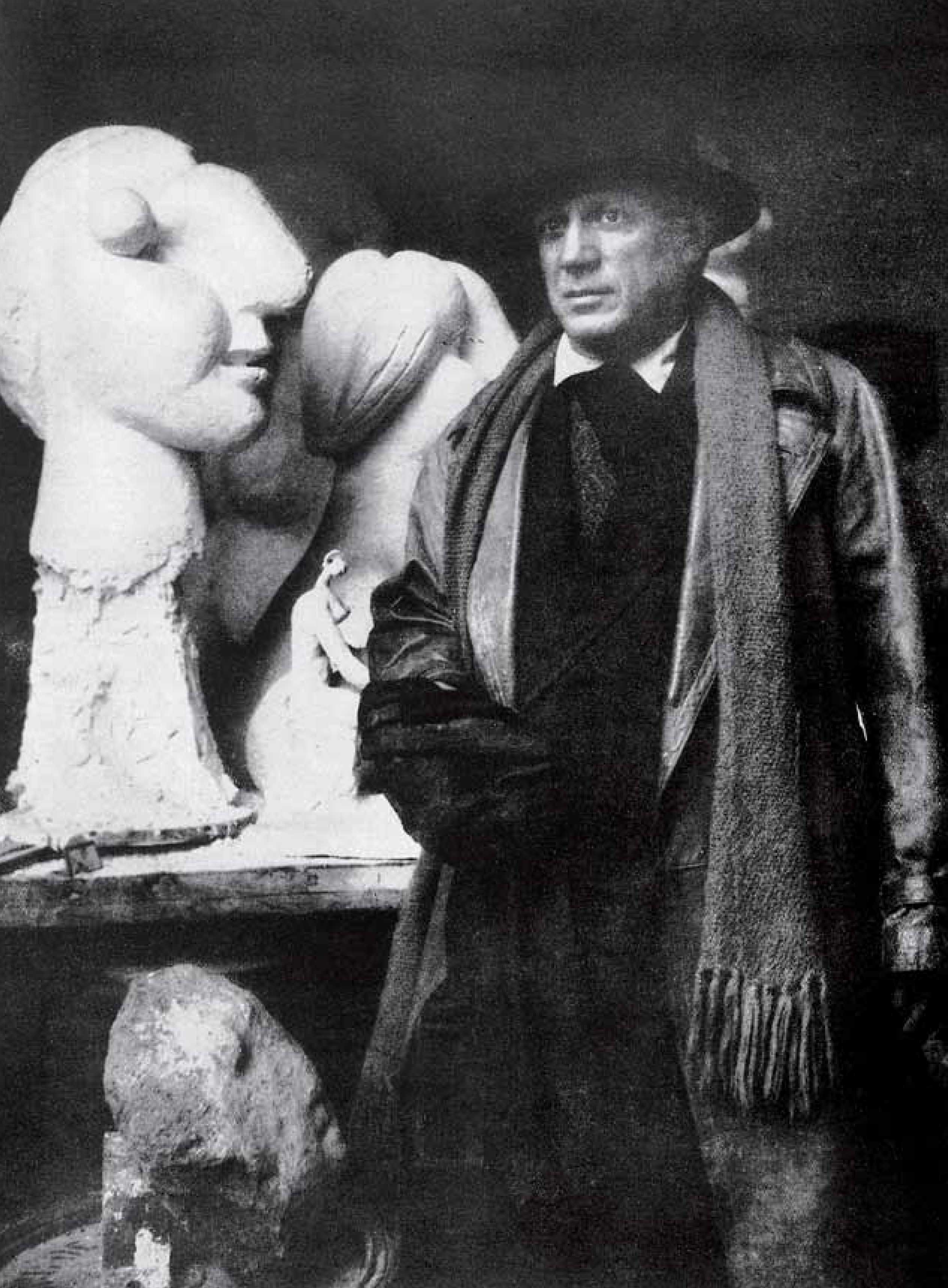 Picasso in his sculptor studio at Boisgeloup.
Picasso in his sculptor studio at Boisgeloup.
1934
Picasso: Suite Vollard
This series of 100 engravings by Picasso, ordered by Ambroise Vollard, one of the legendary art dealers of the period, was purchased by Fundacion Mapfre in 2008. Suite Vollard is considered one of the most important artworks of the 20th century. These plates proved once again that Picasso was not only a painter but also a famous sculptor, ceramist and engraver.
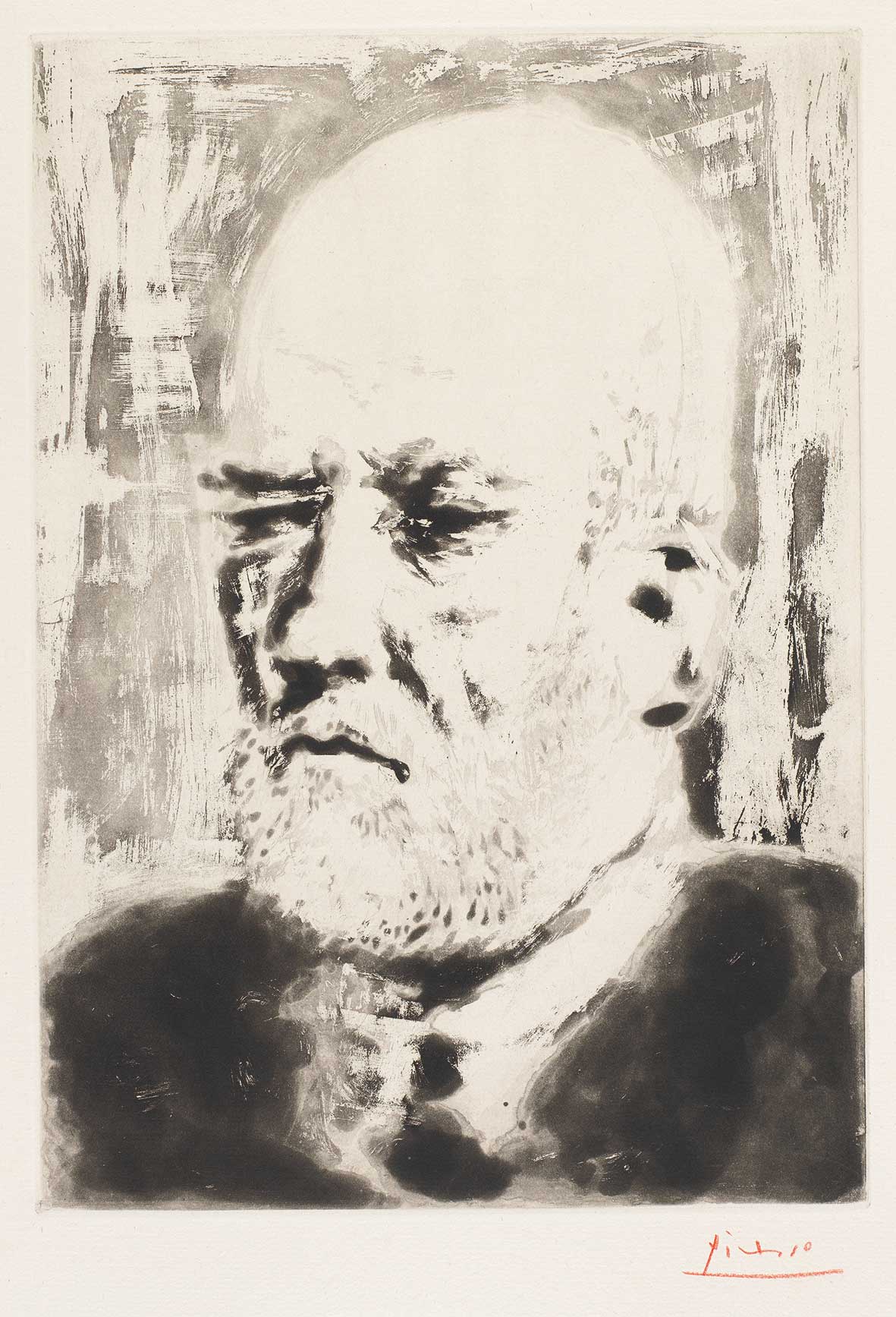 Portrait of Vollard II
Portrait of Vollard II
c.1937
Aquatint / Montval laid paper
348 x 247 mm / 440 x 340 mm
Picasso: Suite Vollard
Perhaps the only thing we can say for sure about Suite Vollard is its melancholy dream state. In this series we can find everything, or nothing. In these 100 prints, the artist also demonstrates his skill; he plays with the so-called 'Ingres style', stripping it of all its formal contradictions and deformations and shaping an extraordinary and exciting narrative capacity.
Suite Vollard included 100 copper engravings produced between 1930 and 1937, covering a variety of themes and not in an exact chronological order. Picasso used a variety of techniques to accomplish this series: burin (pencil etching), etching, aquatint (spot printing), lavish, cold engraving, and even a combination of these.
In the year he completed the series, Picasso was also making Guernica, perhaps his most famous work ever. Here bulls and horses expressed the brutality. Drama and violence were shown through the woman who symbolizes humanity and virtue, the woman screaming or holding her dead son in her arms. Guernica was the opposite of the 1920s and 1930s image of happiness and abundance.
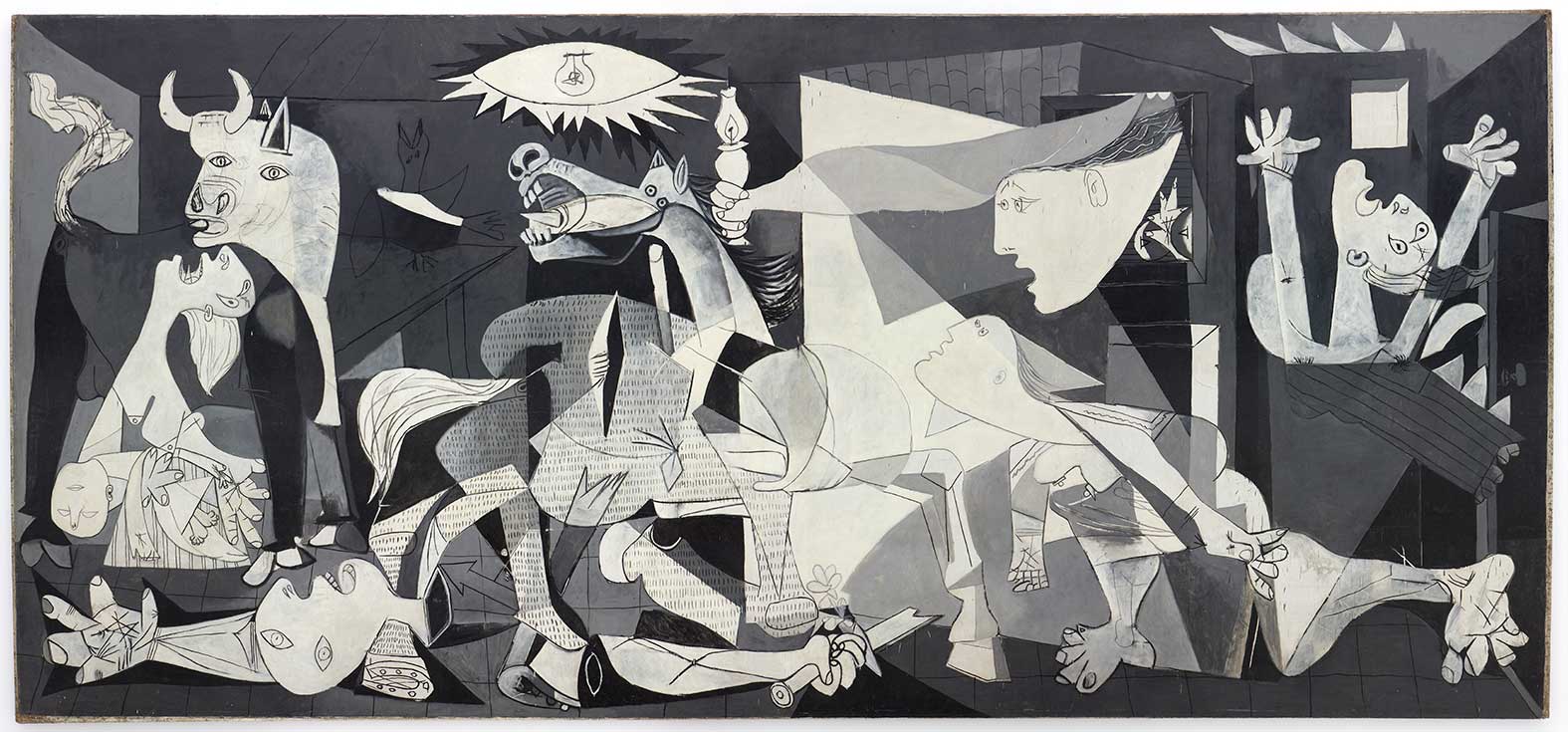 Guernica, 1937, Centro de Arte Reina Sofia
Guernica, 1937, Centro de Arte Reina Sofia
Picasson's paintings offered us an infinite oscillation between themes, techniques and styles, and this was also evident in his engravings. Suite Vollard has been a compilation of all these; the specific meaning of any motif became less important than the overall meaning of the plates that successfully described themselves. Some were classics, some were full of vitality. Others were more expressive. Meanwhile, Picasso, who is also known for his famous words, did not seek a final quality at any point in his work: “To finish a work? To finish a picture? What nonsense! To finish it means to be through with it, to kill it, to rid it of its soul – to give it its final blow; the most unfortunate one for the painter as well as for the picture.”
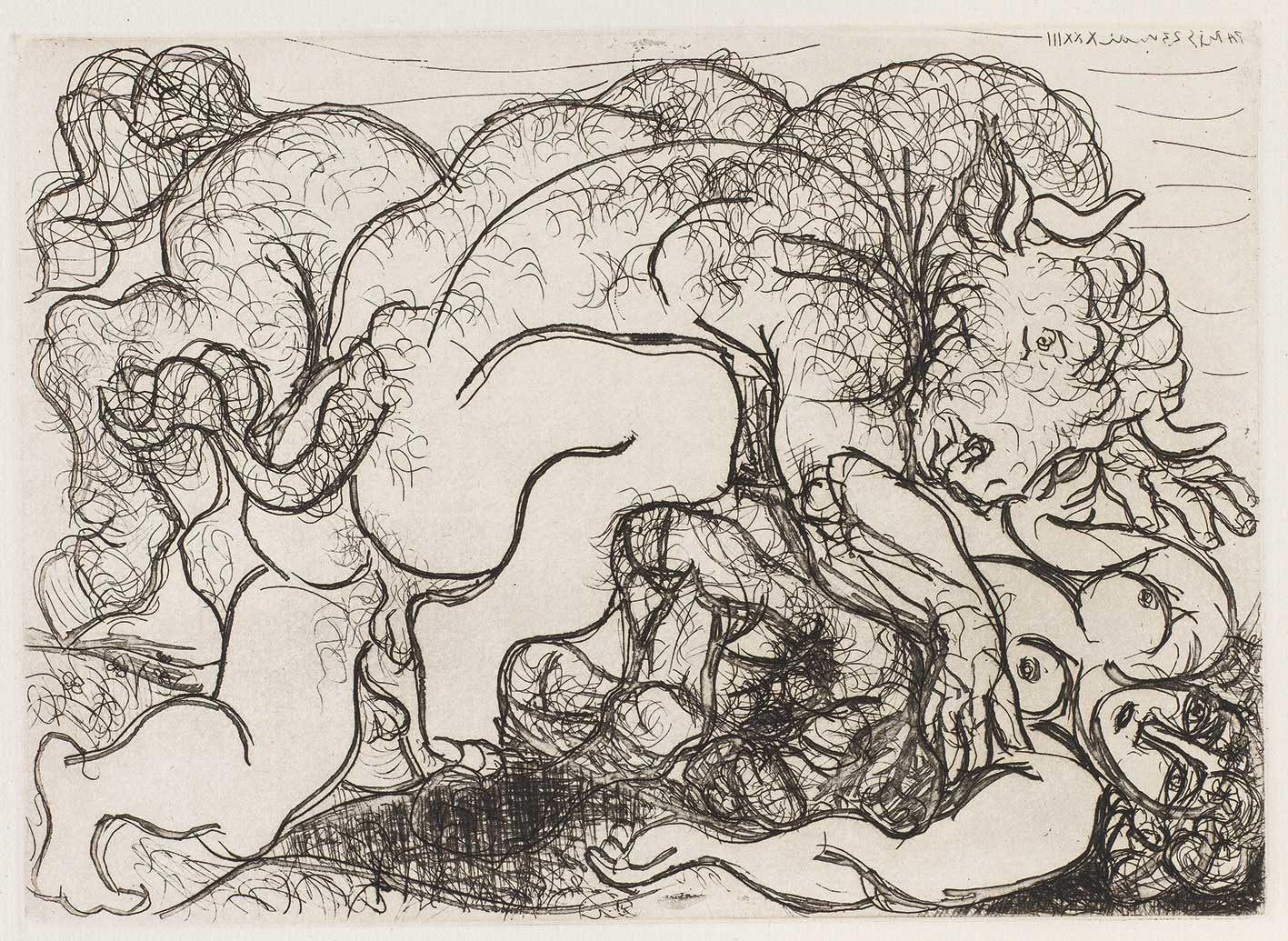 Minataur Attacking an Amazon. 23 May 1933. Etching, Montval laid paper. 194 x 268 mm / 450 x 340 mm. Picasso: Suite Vollard
Minataur Attacking an Amazon. 23 May 1933. Etching, Montval laid paper. 194 x 268 mm / 450 x 340 mm. Picasso: Suite Vollard
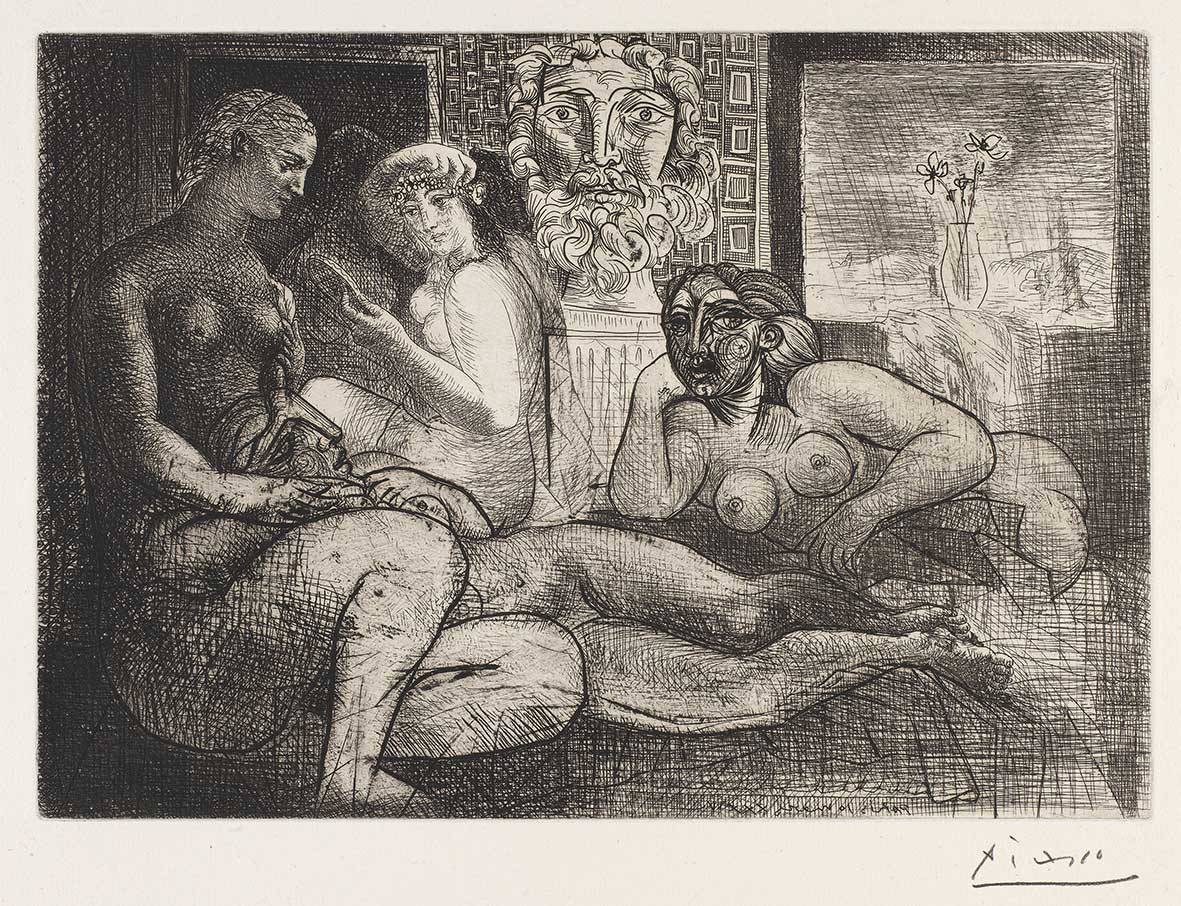 Four Nude Women and Sculpted Head. 10 March 1934. Etching and burin / Montval laid paper 223 x 316 mm / 340 x 445 mm. Picasso: Suite Vollard
Four Nude Women and Sculpted Head. 10 March 1934. Etching and burin / Montval laid paper 223 x 316 mm / 340 x 445 mm. Picasso: Suite Vollard

Inspired by its Anatolian Weights and Measures Collection, Pera Museum presents a contemporary video installation titled For All the Time, for All the Sad Stones at the gallery that hosts the Collection. The installation by the artist Nicola Lorini takes its starting point from recent events, in particular the calculation of the hypothetical mass of the Internet and the weight lost by the model of the kilogram and its consequent redefinition, and traces a non-linear voyage through the Collection.
Tuesday - Saturday 10:00 - 19:00
Friday 10:00 - 22:00
Sunday 12:00 - 18:00
The museum is closed on Mondays.
On Wednesdays, the students can
visit the museum free of admission.
Full ticket: 300 TL
Discounted: 150 TL
Groups: 200 TL (minimum 10 people)